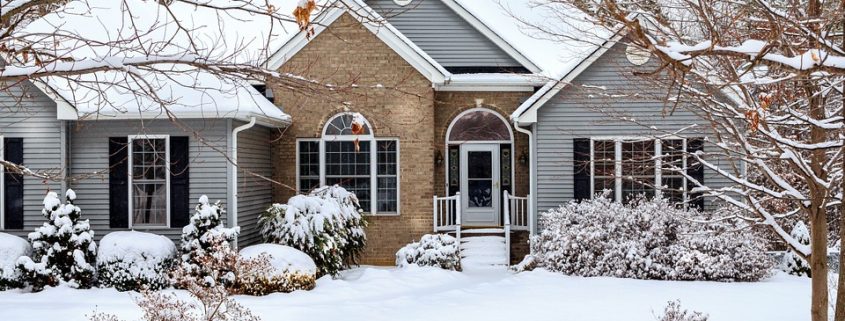10 Tips to Winterize your Home
Did you know that winterizing your home will prevent any damages and save you money? Is winterizing your home a foreign term to you? Don’t worry; you have come to the right place!
Fall Equinox is the right time of year to start preparing your home for winter, because as the temperate beings to decline, your home will need some preparation and maintenance to keep it in top-notch shape through winter.
Here is a list of our 10 Tips to Winterize your Home.
- Furnace Inspection
As the temperature dips, the last thing you want to think about is whether your home will be warm. During the winter is when your furnace will be used the most, so now is the best time to make sure it will provide you with the indoor comfort throughout the cold season. The best place to start is by calling an HVAC professional to inspect your furnace and clean the ducts. Also, if you don’t already have one, a programmable thermostat is a great way to save energy and money. - Check the Exterior Doors and Windows
The exterior doors and windows are where the heat will escape and the cold air will come in. This is the time to inspect exterior for crevice cracks and exposed entry points around pipes; seal them. Use weather-stripping around doors to prevent cold air from entering the home and caulk windows. You should also replace cracked glass in windows and, if you end up replacing the entire window, prime and paint exposed wood. Also, if your home has a basement, consider protecting its window wells by covering them with plastic shields. - Inspect Roof, Gutters, & Downspouts
Does the temperature fall below freezing during winter in your area? Adding extra insulation to the attic will prevent warm air from creeping to your roof and causing ice dams. It’s also always a good idea to check flashing to ensure water cannot enter the home and replace worn roof shingles or tiles. Now is also the time to clean out the gutters and use a hose to spray water down the downspouts to clear away debris. Installing leaf guards on the gutters or extensions on the downspouts to direct water away from the home will also help prevent any damage to your home. - Prevent Plumbing Freezes
If you are in a new home it is a good idea to figure out where your water main is in the event you need to shut it off in an emergency. All garden hoses needs to be drained and insulate all exposed plumbing pipes and faucets to ensure it doesn’t freeze. If you have an air conditioner, be sure to drain all the pipes and if your unit has a water shut off valve, turn it off. Are you going away at all during the winter months? Make sure you leave the heat on; set to at least 15 degrees Celsius. - Get the Fireplace Ready
Weather you have a wood burning or a gas fireplace; it probably hasn’t been used all summer long. Now that it’s cooler you may want to turn it on to take away that bite in the air or for a nice cozy feel. However if the chimney hasn’t been cleaned for a while, call a chimney sweep to remove soot and creosote and clean the inside of all dust and debris before lighting. The chimney sweep should also be able to help you inspect the damper to ensure it opens and closes properly. The top of the chimney should also be capped or screened to keep rodents and birds out. - Install Smoke and Carbon Monoxide Detectors
Some cities require a smoke detector in every room. These should be tested to ensure they are working. It is always a good idea to buy extra batteries for the smoke detectors and change them when daylight saving ends. Installing a carbon monoxide detector near your furnace or water heater is an extra precaution every home should consider. If you already have a carbon monoxide detector, this should also be tested to make sure it is working. Every home should have a fire extinguisher and should be replaced every 10 years. - Check Foundations
The foundation of your home is one of the most important parts. It is essential that yourake away all debris and edible vegetation from the foundation to avoid any flooding where water could drain away. Also, Seal up entry points to keep small animals from crawling under the house and seal foundation cracks. Mice can slip through space as thin as a dime. - Prepare Landscaping & Outdoor Surfaces
The winter months can really cause havoc on your outdoor landscaping and surfaces. It’s a smart idea to ask a gardener or landscaper when your trees and hedges should be pruned to prevent winter injury. Also, plant spring flower bulbs and lift bulbs that cannot winter over such as dahlias in areas where the ground freezes. Move sensitive potted plants indoors or to a sheltered area. Don’t automatically remove dead vegetation from gardens as some provide attractive scenery in an otherwise dreary, snow-drenched yard. Trimming your trees if the branches hang too close to the house or electrical wires can prevent any future damage as well. - Service Weather-Specific Equipment
This is something many people forget and doesn’t get done until the next year or when it’s too late. A few things are:- Drain gas from lawnmowers.
- Service or tune-up snow blowers.
- Replace worn rakes and snow shovels.
- Clean, dry and store summer gardening equipment.
- Sharpen ice choppers and buy bags of ice-melt / sand.
- Prepare an Emergency Kit
You should have an emergency kit all year round. However, during the winter months is when not being prepared could be life threatening. Your emergency kit should have a few essentials like candles and matches or lighter, emergency blanket, battery pack for a computer/cellphone to stay in contact with people, lists of important phone numbers, and bottled water and non-perishable food (include pet food if you have a pet).






